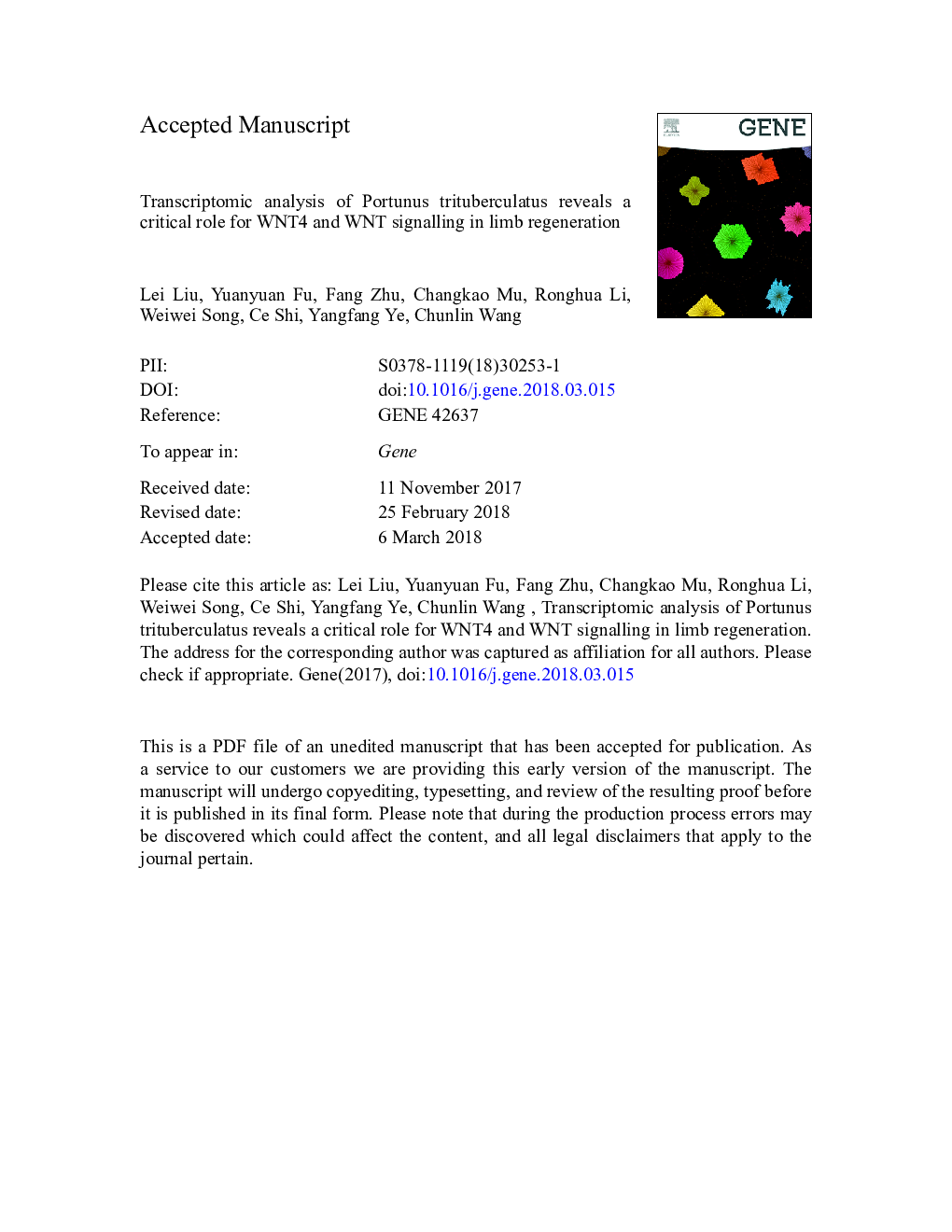| کد مقاله | کد نشریه | سال انتشار | مقاله انگلیسی | نسخه تمام متن |
|---|---|---|---|---|
| 8645262 | 1569778 | 2018 | 46 صفحه PDF | دانلود رایگان |
عنوان انگلیسی مقاله ISI
Transcriptomic analysis of Portunus trituberculatus reveals a critical role for WNT4 and WNT signalling in limb regeneration
دانلود مقاله + سفارش ترجمه
دانلود مقاله ISI انگلیسی
رایگان برای ایرانیان
کلمات کلیدی
CAF1Grin2BVDRWNT4ACTGFD4LRP2Portunus trituberculatusHus1CoQRNAPEIF5APRC1NAV2FYVEGliSmoxSYNE1ABCBActnGCH1Fli1SLC22Dynein heavy chainSVCSCCDCVPS13CRPL18TLX3Ror2AEPTNCGAPDHACPBRCGDHTFChsp70SBCGPCRKHCPKCPLA2CBPRBPDSCAMABCB1LIMMAPK - MAPKLAMA - OLDsSAT - SSATphospholipase A2 - آنزیم فسفولیپاز A2 spermine oxidase - اسپرمین اکسیدازactin - اکتین Limb regeneration - بازسازی اندامTranscriptome - ترانسکریپتومCrustacean - خرچنگkinesin heavy chain - زنجیره سنگین kinesinCalp - سرپناهSyn - سینتWnt signalling - سیگنال WntVascular Endothelial Growth Factor (VEGF) - فاکتور رشد اندوتلیال عروقی (VEGF)Down syndrome cell adhesion molecule - مولکول چسبندگی سلول سندرم داونheat shock protein 70 - پروتئین شوک حرارت 70Cuticular protein - پروتئین کوتیکولیکGlucose dehydrogenase - گلوکز دی هیدروژناز
موضوعات مرتبط
علوم زیستی و بیوفناوری
بیوشیمی، ژنتیک و زیست شناسی مولکولی
ژنتیک
پیش نمایش صفحه اول مقاله

چکیده انگلیسی
The swimming crab (Portunus trituberculatus) is among the most economically important seawater crustacean species in Asia. Despite its commercial importance and being well-studied status, genomic and transcriptomic data are scarce for this crab species. In the present study, limb bud tissue was collected at different developmental stages post amputation for transcriptomic analysis. Illumina RNA-sequencing was applied to characterise the limb regeneration transcriptome and identify the most characteristic genes. A total of 289,018 transcripts were obtained by clustering and assembly of clean reads, producing 150,869 unigenes with an average length of 956â¯bp. Subsequent analysis revealed WNT signalling as the key pathway involved in limb regeneration, with WNT4 a key mediator. Overall, limb regeneration appears to be regulated by multiple signalling pathways, with numerous cell differentiation, muscle growth, moult, metabolism, and immune-related genes upregulated, including WNT4, LAMA, FIP2, FSTL5, TNC, HUS1, SWI5, NCGL, SLC22, PLA2, Tdc2, SMOX, GDH, and SMPD4. This is the first experimental study done on regenerating claws of P. trituberculatus. These findings expand existing sequence resources for crab species, and will likely accelerate research into regeneration and development in crustaceans, particularly functional studies on genes involved in limb regeneration.
ناشر
Database: Elsevier - ScienceDirect (ساینس دایرکت)
Journal: Gene - Volume 658, 5 June 2018, Pages 113-122
Journal: Gene - Volume 658, 5 June 2018, Pages 113-122
نویسندگان
Lei Liu, Yuanyuan Fu, Fang Zhu, Changkao Mu, Ronghua Li, Weiwei Song, Ce Shi, Yangfang Ye, Chunlin Wang,